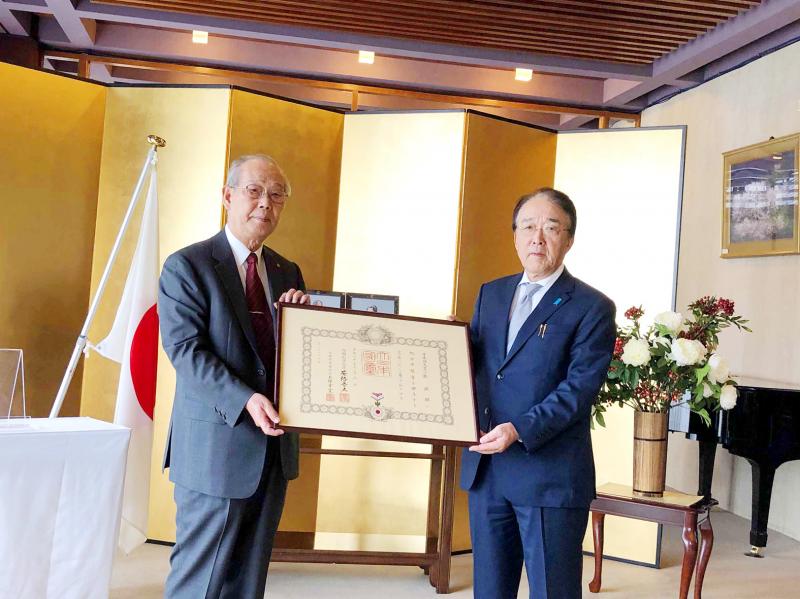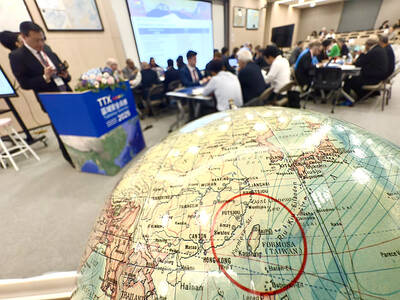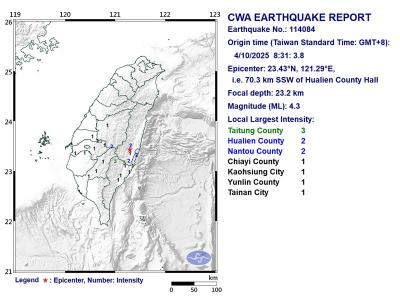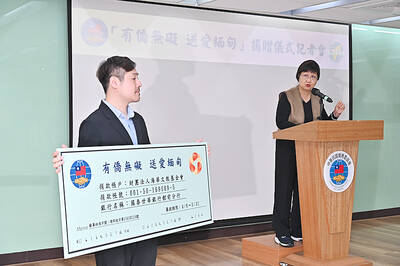Taiwan-Japan relations are “always good,” but as with any couple, the occasional dispute is inevitable, a government official said, as interaction between the two nations has recently experienced ups and downs.
Ties between Taiwan and Japan have been informal since Tokyo switched recognition from Taipei to Beijing in 1972.
Since the outbreak of COVID-19 late last year, Japanese Prime Minister Shinzo Abe has repeatedly voiced support for Taiwan’s bid to join the WHO and its decisionmaking body, the World Health Assembly (WHA), which has denied Taiwan observer status since 2017.

Photo: CNA
Japan last month for the first time stated a policy of supporting Taiwan’s WHA bid in its Diplomatic Bluebook for this year and called Taiwan an “extremely important partner,” stronger than last year’s “crucial partner and an important friend.”
Tokyo has also welcomed Taiwan’s bid to join the Japan-led Comprehensive and Progressive Agreement for Trans-Pacific Partnership and given Taipei informal advice on how to gain the support of member states pressured by Beijing, a Ministry of Foreign Affairs official said on condition of anonymity.
Despite an evident rapport, a sticking point in Taiwan-Japan relations resurfaced over the Diaoyutai Islands (釣魚台), when Okinawa’s Ishigaki City Council on Tuesday proposed a bill to change the islands’ administrative name to Tonoshiro Senkaku.
The group of uninhabited islands in the East China Sea, known as the Senkaku Islands in Japan, are claimed by Taiwan, Japan and China.
The bill was introduced as a response to Chinese Coast Guard vessels passing near the Diaoyutais last month, not as a bid to provoke Taiwan, the ministry official told the Taipei Times.
Unnerved by Chinese maritime expansion, the Abe government has become more reserved toward China, its enthusiasm cooling over inviting Chinese President Xi Jinping (習近平) to Japan, as planned after the two leaders met in Beijing in December last year, the official said.
Japan and the US are allies in defending the security and stability of the Indo-Pacific region, and while Japan has its own considerations in some instances, the backbone of its diplomatic policy is to follow the US’ lead, the official said.
Although the bill was not a provocation of Taiwan, Ishigaki should consider dropping the proposal for the sake of the friendship between the two nations, especially after Taiwanese fishers in Yilan County’s Suao Township (蘇澳) protested the change, the official said, adding that a similar bill was passed by the council in 2018, but not implemented for some reason.
However, the city council might carry out the new bill if it is passed in a June 22 vote, the official said.
As a bid to pre-empt the vote in Ishigaki, the Yilan County Council on Thursday passed a provisional motion recommending that the islands be renamed Toucheng Township Diaoyutai (頭城釣魚台).
“Taiwan-Japan ties are a rare jewel among bilateral relations around the world,” the ministry official said. “People on both sides should cherish such a friendship.”
Since Taiwan and Japan signed a fisheries agreement in 2013, the two nations have agreed to shelve Diaoyutai sovereignty disputes and instead focused on setting up operational rules for fishing boats in an agreed-upon sea area, the official said.
Other disputes — such as the waters north of 27 degrees north latitude or the waters south of the Yaeyama Islands — are not addressed in the countries’ annual fisheries talks, but Coast Guard Administration personnel continue to protect local fishers’ rights within Taiwan’s provisional law enforcement zone, the official added.
Taiwan and Japan in 2016 began a dialogue on marine affairs in the western Pacific and have signed memorandums of understanding on cooperating in coast guard rescue efforts, smuggling prevention, ocean research and solutions to marine garbage, the official said.
Taiwan does not take a position on whether Okinotori is an island or a reef — whether Japan can claim an exclusive economic zone (EEZ) hinges on the answer — but is waiting for the UN Convention on the Law of the Sea to reach a conclusion, the official said, adding that Japan should respect other countries’ rights to operate in nearby waters.
National Taiwan University Institute of Oceanography professor Hsieh Chih-hao (謝志豪) has questioned the effectiveness of the annual fisheries meetings, saying that discussion on important problems, such as tagging methods for stock assessment, has not translated into effective Taiwan-Japan research cooperation.
However, Taiwan and Japan have cooperated on determining total allowable catches and catch quotas for each member state in the multilateral North Pacific Fisheries Commission, even though China and Vanuatu keep boycotting the implementation of caps, he said.
Despite warmer relations with Taiwan in the wake of the March 2011 earthquake, tsunami and nuclear disaster in Fukushima Prefecture, Japan has become increasingly defensive of its territorial waters as it pushes back against China’s maritime ambitions in the Pacific, Hsieh said.
As the result of pressure from China and Japan, Taiwanese scientists have been restricted to conducting surveys in smaller sea areas, unlike years ago when his team could collect plankton samples at the mouth of the Yangtze River or within Japan’s EEZs in the East China Sea, he added.
Taiwan-Japan collaborations in ocean research have mostly been continued by individual scientists or universities, Hsieh said, adding that although he could conduct a survey aboard a Japanese research vessel, it is difficult for Taiwanese research vessels to enter Japan’s territorial waters.
So that more local researchers can make scientific breakthroughs, the government should promote Taiwan-Japan collaboration on projects at higher levels, Hsieh said, suggesting that a good place to start would be a joint survey of the Kuroshio Current.
Strong connections between civic groups have been the bedrock of bilateral relations since Japan cut formal ties with Taiwan in 1972, Taiwan-Japan Cultural and Economic Association honorary chairman Cheng Chi-yao (鄭祺耀) said, adding that President Tsai Ing-wen’s (蔡英文) administration has failed to make good use of these connections to advance diplomatic ties.
Cheng in 2018 received the Order of the Rising Sun from Japanese Emperor Akihito in recognition of his contribution to exchanges between the two countries.
In the same year, Cheng and former Japanese representative to Taiwan Mikio Numata were instrumental — after formal negotiations had stalled for years — in getting approval for a Taiwanese research vessel to install ocean bottom seismometers in Japan’s EEZ near the Northern Okinawa Trough.
Despite its “one China” policy, Japan feels more affinity toward Taiwan due to shared values, Cheng said.
Democratic values bond Japan and Taiwan together, while mutual benefit and honesty are essential for sustaining enduring ties, he said.

Taiwan is stepping up plans to create self-sufficient supply chains for combat drones and increase foreign orders from the US to counter China’s numerical superiority, a defense official said on Saturday. Commenting on condition of anonymity, the official said the nation’s armed forces are in agreement with US Admiral Samuel Paparo’s assessment that Taiwan’s military must be prepared to turn the nation’s waters into a “hellscape” for the Chinese People’s Liberation Army (PLA). Paparo, the commander of the US Indo-Pacific Command, reiterated the concept during a Congressional hearing in Washington on Wednesday. He first coined the term in a security conference last

DEFENSE: The National Security Bureau promised to expand communication and intelligence cooperation with global partners and enhance its strategic analytical skills China has not only increased military exercises and “gray zone” tactics against Taiwan this year, but also continues to recruit military personnel for espionage, the National Security Bureau (NSB) said yesterday in a report to the Legislative Yuan. The bureau submitted the report ahead of NSB Director-General Tsai Ming-yen’s (蔡明彥) appearance before the Foreign and National Defense Committee today. Last year, the Chinese People’s Liberation Army (PLA) conducted “Joint Sword-2024A and B” military exercises targeting Taiwan and carried out 40 combat readiness patrols, the bureau said. In addition, Chinese military aircraft entered Taiwan’s airspace 3,070 times last year, up about

A magnitude 4.3 earthquake struck eastern Taiwan's Hualien County at 8:31am today, according to the Central Weather Administration (CWA). The epicenter of the temblor was located in Hualien County, about 70.3 kilometers south southwest of Hualien County Hall, at a depth of 23.2km, according to the administration. There were no immediate reports of damage resulting from the quake. The earthquake's intensity, which gauges the actual effect of a temblor, was highest in Taitung County, where it measured 3 on Taiwan's 7-tier intensity scale. The quake also measured an intensity of 2 in Hualien and Nantou counties, the CWA said.

The Overseas Community Affairs Council (OCAC) yesterday announced a fundraising campaign to support survivors of the magnitude 7.7 earthquake that struck Myanmar on March 28, with two prayer events scheduled in Taipei and Taichung later this week. “While initial rescue operations have concluded [in Myanmar], many survivors are now facing increasingly difficult living conditions,” OCAC Minister Hsu Chia-ching (徐佳青) told a news conference in Taipei. The fundraising campaign, which runs through May 31, is focused on supporting the reconstruction of damaged overseas compatriot schools, assisting students from Myanmar in Taiwan, and providing essential items, such as drinking water, food and medical supplies,